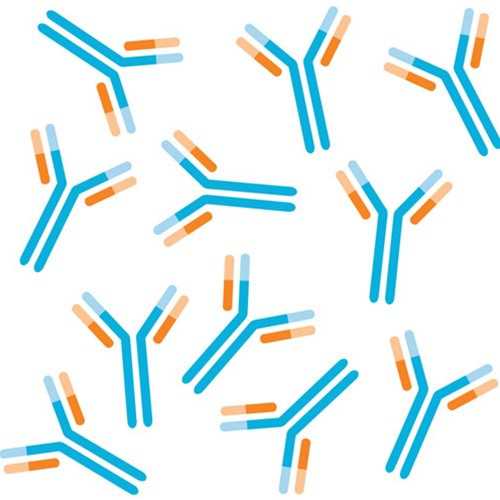Anti-Ring-Box 1 (RBX1/ROC1C) Antibody
This rabbit polyclonal antibody was generated against a synthetic peptide corresponding to amino acids 97-108 of human ring-box 1 (RBX1/ROC1, c-terminus) and recognizes human, mouse, zebrafish, drosophila, C. elegans, S. cerevisiae RBX1.
Highlights:
- human, mouse, zebrafish, drosophila, C. elegans, S. cerevisiae RBX1/ROC1
- Suitable for Western Blot and ELISA applications
ROC1 also known as RING-box protein 1, Rbx1, Regulator of cullins 1, RING finger protein 75, and ZYP protein, is a component of the SCF (SKP1-CUL1-F-box protein) and the CBC(VHL) (CUL2-elonging BC-VHL) E3 ubiquitin ligase complexes, which mediate the ubiquitination and subsequent proteasomal degradation of target proteins involved in cell cycle progression, signal transduction and transcription. ROC1 appears to recruit the E2 ubiquitination enzyme through the RING-type zinc finger in a manner similar to CDC34, and brings it into close proximity to the substrate. The RING-type zinc finger domain is essential for ubiquitin ligase activity. ROC1 probably also stimulates CDC34 autoubiquitination and promotes the neddylation of CUL1 and probably CUL2. ROC1 has a cytoplasmic and nuclear localization and is widely expressed in most tissues.
From the laboratory of Yue Xiong, PhD, University of North Carolina Chapel Hill.
This rabbit polyclonal antibody was generated against a synthetic peptide corresponding to amino acids 97-108 of human ring-box 1 (RBX1/ROC1, c-terminus) and recognizes human, mouse, zebrafish, drosophila, C. elegans, S. cerevisiae RBX1.
Highlights:
- human, mouse, zebrafish, drosophila, C. elegans, S. cerevisiae RBX1/ROC1
- Suitable for Western Blot and ELISA applications
ROC1 also known as RING-box protein 1, Rbx1, Regulator of cullins 1, RING finger protein 75, and ZYP protein, is a component of the SCF (SKP1-CUL1-F-box protein) and the CBC(VHL) (CUL2-elonging BC-VHL) E3 ubiquitin ligase complexes, which mediate the ubiquitination and subsequent proteasomal degradation of target proteins involved in cell cycle progression, signal transduction and transcription. ROC1 appears to recruit the E2 ubiquitination enzyme through the RING-type zinc finger in a manner similar to CDC34, and brings it into close proximity to the substrate. The RING-type zinc finger domain is essential for ubiquitin ligase activity. ROC1 probably also stimulates CDC34 autoubiquitination and promotes the neddylation of CUL1 and probably CUL2. ROC1 has a cytoplasmic and nuclear localization and is widely expressed in most tissues.
From the laboratory of Yue Xiong, PhD, University of North Carolina Chapel Hill.
| Product Type: | Antibody |
| Name: | Anti-Ring-Box 1 (RBX1/ROC1C) Antibody |
| Antigen: | ROC1-C |
| Accession ID: | P62877 |
| Molecular Weight: | Detects a band of approximately 12.2 kDa (predicted molecular weight: 12 kDa) |
| Clonality: | Polyclonal |
| Reactivity: | human, mouse, zebrafish, drosophila, C. elegans, S. cerevisiae |
| Immunogen: | This antibody was prepared from whole rabbit serum produced by repeated immunizations with a synthetic peptide corresponding to amino acids 97-108 of Human ROC1 (C-terminal) coupled to KLH. |
| Species Immunized: | Rabbit |
| Epitope: | Peptide corresponding to amino acids 94-108 (CPLDNREWEFQKYGH) at C-terminus of human ROC1 coupled to KLH. |
| Buffer: | Serum with 0.01% (w/v) Sodium Azide |
| Tested Applications: | Western Blot : 1:500 - 1:1,000; HeLa, 3T3 cell lines ELISA : 1:2,000 - 1:10,000; ImmunoPrecipitation: 1:500 |
| Storage: | Store serum at -20° C prior to opening. Aliquot contents and freeze at -20° C or below for extended storage. Avoid cycles of freezing and thawing. Centrifuge product if not completely clear after standing at room temperature. This product is stable for several weeks at 4° C as an undiluted liquid. Dilute only prior to immediate use. |
| Shipped: | Cold Packs (Domestic, Overnight); Dry Ice (International) |
This antibody reacts with human ROC1 by western blot and immunoprecipitation. The antibody immunoprecipitates in vitro translated protein and protein from overexpressing cell lysates (using HeLa and NIH-3T3, and others). Coimmunopreciptation of related cullin proteins does occur. Coimmunoprecipitation of ubiquitin ligase activity will also occur. A 12.2 kDa band corresponding to human ROC1 is detected. Most cell lines expressing ROC1 can be used as a positive control. Researchers should determine optimal titers for other applications.
This locus encodes a RING finger-like domain-containing protein. The encoded protein interacts with cullin proteins and likely plays a role in ubiquitination processes necessary for cell cycle progression. This protein may also affect protein turnover.
- Ohta et al. (1999) Molecular Cell 3:535-541.
- Ohta et al. (1999) Oncogene, 18:6758-6766.
- Tan et al., (1999) Molecular Cell 3:527-533.
- Skowyra et al. (1999) Science 284:662-665.
- Kamura et al. (1999) Science 284:657-661.
- Seol et al., (1999) Genes & Dev. 13:1614-1626.
- Furukawa et al. (2003) Nature Cell Biol.5: 1001-1007.
- Hu et al. (2004) Nature Cell Biol. 6: 1003-1010.
- Furukawa et al. (2005) Mol and Cellular Biol. 25: 162-171.
- Hu et al. (2008) Genes & Dev. 22: 866.
- Nakagawa et al. (2011) Mol Cell 43: 381-91.
If you publish research with this product, please let us know so we can cite your paper.


